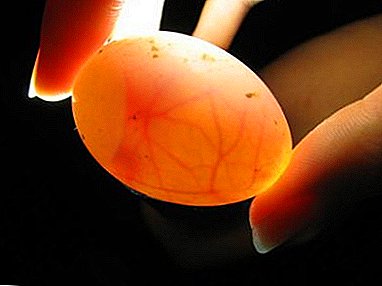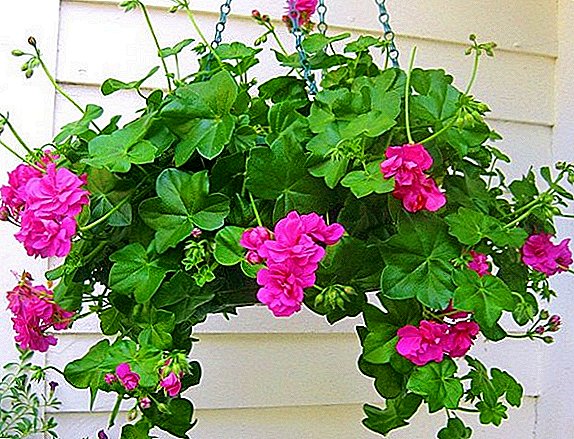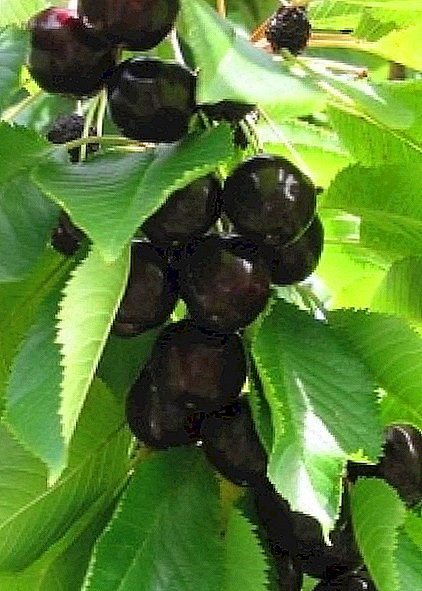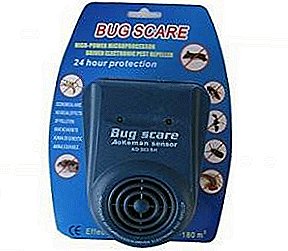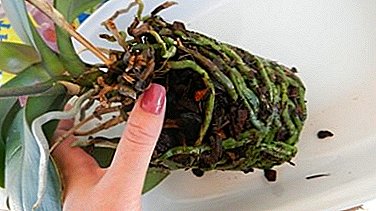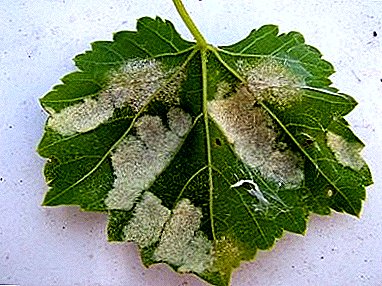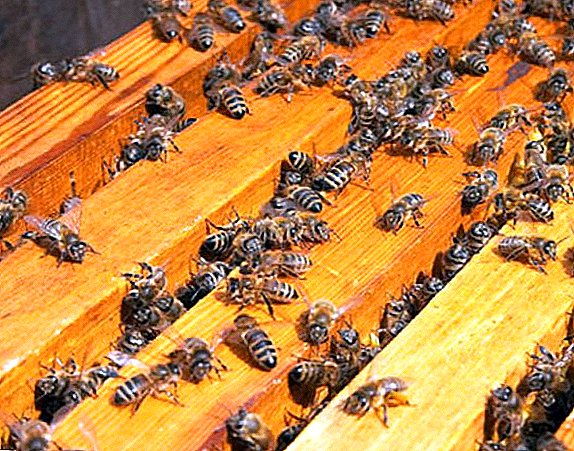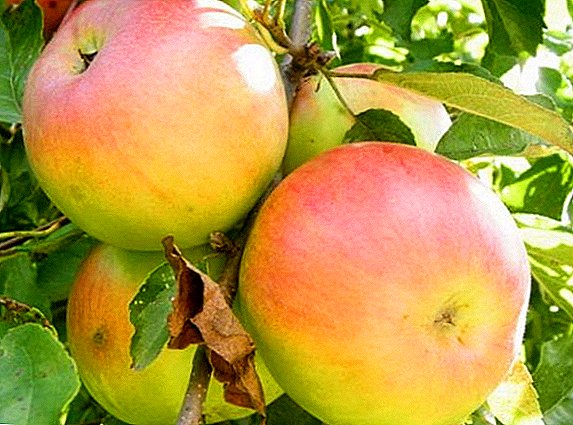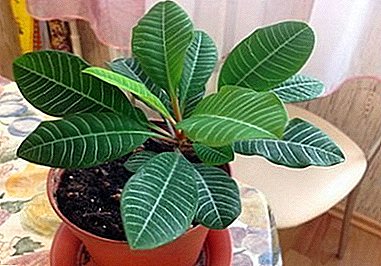
Euphorbia white-toed The most common among euphorns grown indoors.
Sometimes it is called a cactus because of the thick stem, and sometimes a palm tree because of the lush foliage at the top of the trunk.
Belozhilkovy spurge often confused with comb euphorbia.
To correctly determine the type, you need pay attention to streaks. In belozhilkovy they are clearly expressed, moreover, exactly belozhilkovy has the appearance of a palm tree, it is the most decorative.
Description
Homeland milkweed is Madagascar. Now it is found in subtropical America and Africa.
Stem
At the bottom of the round, tight, thin. Up thickens, becomes ribbed, usually has 4-5 ribs, on the edge of which are fringed stipules. Gradually, with the growth of the trunk bare bottom. With proper care, a white-stalked (white-clothed) indoor flower euphorbia can grow up to two meters.
Leaves
 Dark yellow leaves have streaks of white, grow on long petioles, having a reddish color, are also long, there are up to 20 cm
Dark yellow leaves have streaks of white, grow on long petioles, having a reddish color, are also long, there are up to 20 cm
Young leaves grow at the top, on the top, which makes the plant look like a palm tree.
Flower
Flowering is not among the advantages of this succulent.
Bracts consist of hard scales, from which flowers look like thin white threads. Overall flower It looks extremely homely.
Fetus
After flowering, there remains a box with three nests inside, where the seeds ripen. After the seeds have fully ripened, it cracks, the seeds are scattered in different directions and germinate quickly in all adjacent pots. For this, spurge is popularly called "splashes of champagne".
If there is a need to collect seeds, then monitor the maturation of the box and have time to remove before it cracks.
A photo
Then you can see Euphorbia Belozhilkovy (belozhilchaty) in the photo:


Such types of euphorbia are very popular among florists: Multiflora, Edged, Cypress, Tirukalli, Pallas, Mil, Trihedral.
Home care
Growing euphorbia belozhilchaty (belozhilkovy) at home, you will understand that this is one of the easiest in the care of plants.
Landing
Before planting in a pot stack high drainage layer, it is better if it is a crushed brick or expanded clay.
This succulent plant without drainage can'tbecause at the slightest stagnation of water roots and stem can rot.
It is better to take a pot shallow, but rather wide. When the plant reaches a very impressive size, in addition to the drainage pot, you should also put several stones. Otherwise, spurge can outweigh the crownand the pot will fall to the side. When planting it is necessary to ensure that the plant is located exactly in the middle of the tank.
Transfer
How to transplant milkweed? Young euphorias annually transplanted into fresh soil, old ones less often, it is enough to do it every 2-3 years.
Young euphorias annually transplanted into fresh soil, old ones less often, it is enough to do it every 2-3 years.
The root system, even for large euphorbia, is small, so you should not take a pot much larger than the previous one when transplanting.
You can replant in any seasonbecause there is no noticeable change of seasons in the homeland of succulent.
Watering
Plant plentiful water in summerwatering for winter reduce and watered only after complete drying of the coma. Use soft, warm water.
Air humidity
Plant does not need in additional air humidification, it well adapted to the level of humidity in the apartment, even to increased dryness in the heating season.
It likes spraying and washing under a warm showerBut these procedures are carried out exclusively for hygienic purposes, because large leaves quickly become covered with dust.
Lighting
Spurge loves the lightbut does not tolerate sunlight, they cause burns on the leaves. It can successfully grow on the northern windowsill and in the depths of the room.
Temperature conditions
 Homeland euphorbia is close to the equator, there is always warm.
Homeland euphorbia is close to the equator, there is always warm.
Euphorbia heat-loving at the level of genes, therefore do not tolerate cold.
If the temperature drops below 15-16 degrees, then spurge can be affected by root rot.
Special protect the roots from hypothermia plants.
The plant loves fresh air, in the summer it can be brought outside, but it must be remembered that it falls ill easily when temperatures drop. As soon as night and daytime temperature drops begin, it should be cleaned into the house.
Priming
The best substrate is sand, peat, humus in equal proportions.
Top dressing
In frequent feeding euphorbia dont needand white-vein is not an exception. It should be fed no more than once a month with fertilizers for cacti, starting in spring and ending in autumn.
Pruning
pruning of milkweed is performed after flowering, shoots are cut about 10-15 cm.
Breeding
How to propagate milkweed? With the multiplication of difficulties does not happen.
With the multiplication of difficulties does not happen.
The easiest-seededwhich are sown on the surface of the substrate and slightly sprinkled on top.
No additional conditions must be observed.
If you regularly water, then shoots appear very quickly, and their active growth begins.
Propagation of euphorbia belozhilchatogo (belozhilkovogo) can be done by cuttings. New succulent can be grown from the lateral process.
It is cut, put in warm water for some time, to let the milky juice flow out, then remove and powder the cut with crushed coal.
The stalk is left to dry for 2-3 days. After it is planted in the ground and placed in a warm place until rooting. Propagate in such a way better at the beginning of summer.
Diseases and pests
Spurge often affected by fungal diseasesthat provoke low temperature and excess moisture. At the first signs of decay conditions need to be changed. May start dropping leaves in very poor light. In this case, the plant is placed on a light, but not sunny window sill.
Major pests:
- spider mite;
- aphid;
- schitovka.
Fight them with traditional methods: wash with soap and water, long kept in the shower, in a pinch treated with chemicals.
Benefit and harm
 Can I keep at home milk euphorbia?
Can I keep at home milk euphorbia?
There is a belief that such a succulent brings home material well-being and calm.
He is loved by connoisseurs of feng shui.
According to them, houseplant euphorbia indoor plants protect the house from unkind forces, it should be installed closer to the door to the apartment. It is recommended to place it and closer to the computer and TV in order to neutralize radiation.
Use in traditional medicine
The healing power of such milkweed has long been known. Healers prepared from it ointment for healing heavy wounds, it was used for the treatment of paralysis, made a means for skin rejuvenation, infusions that relieve swelling. It tends to relieve vomiting, anesthetize, act as a laxative and diaphoretic.
Now doctors prescribe milkweed infusion. with diseases of the stomach and intestines, lungs, hemorrhoids and cystitis.
Danger
 It must be remembered that milk spurge (belozhilchaty), in addition to benefits, can also be harmful.
It must be remembered that milk spurge (belozhilchaty), in addition to benefits, can also be harmful.
For medical purposes, use only roots, and the terrestrial part of euphorbia white-clad poisonous.
Of course, if he just stands on the windowsill, it does no harm to anyone.
What is dangerous indoor flower euphorbia white-leaved?
Only his juice is a threat, he poisonous, contains the substance eufurin.
In no case cannot be allowedso that the children touch the plant, cut off the leaves.
Leaving it in places accessible to domestic animals is also not worth it, although animals at the instinct level are able to recognize dangerous plants and do not touch euphorbia. But because of all this, milk spurge more suitable for officesthan for home.
Juice poisoning
When poisoning can feel dizzy. With these symptoms better turn to the doctors.
Juice on the skin, often causes burn. Affected area need rinse under cold water and take an anti-allergy agent.
Observing all the precautions, you can grow luxurious euphorbia, resembling a palm tree. It will take a worthy place in the collection, decorate any room.
Will play the role of tapeworm in a flower arrangement.



